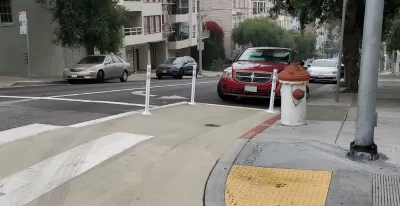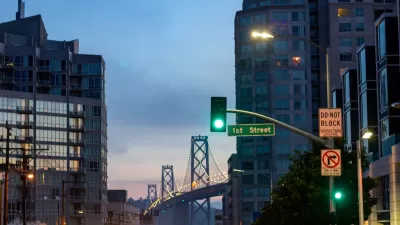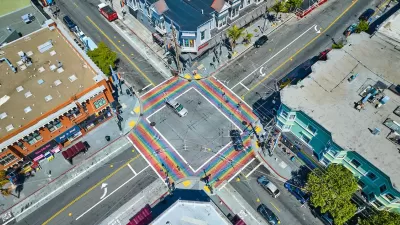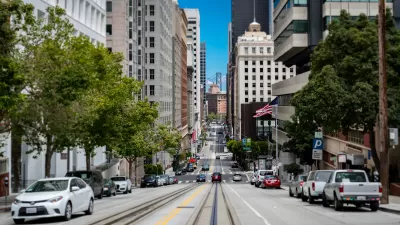A campaign to improve pedestrian safety at dangerous intersections in San Francisco using traffic calming and driver education led to significant reductions in speed and unsafe left turns, according to a report from SFMTA.

A new report from the San Francisco Municipal Transportation Agency (SFMTA) details the results of the agency's Safer Intersections Project, which implemented traffic calming interventions at high-crash intersections in the city as an effort to achieve Vision Zero goals and reduce pedestrian and cyclist deaths. According to a press release, "SFMTA found a 17% reduction in average speed (1.7mph slower) and a 71% reduction in the likelihood of a car turning left at higher speeds over 15mph at seven high-crash test intersections."
The agency used delineator posts, rubber speed bumps, and paint to enhance safety in the test intersections and encourage drivers to make turns more slowly. As part of the project, SFMTA also launched an awareness campaign to educate drivers on safer left turn behavior, funded through a grant from the California Transportation Commission Active Transportation Program.
From the press release:
By changing the architecture of intersections, we were able to move people toward making safer left turns in the moment. The combination of these physical changes and SFMTA’s educational campaign encouraged safe driving behaviors and increased awareness of how individual actions have an impact on the community.
In light of the project's success, the agency recommends traffic calming treatments as a "standard engineering tool" that can be applied widely at dangerous intersections.
FULL STORY: SFMTA Releases Report on Success of Safer Intersections Project

Planetizen Federal Action Tracker
A weekly monitor of how Trump’s orders and actions are impacting planners and planning in America.

Maui's Vacation Rental Debate Turns Ugly
Verbal attacks, misinformation campaigns and fistfights plague a high-stakes debate to convert thousands of vacation rentals into long-term housing.

San Francisco Suspends Traffic Calming Amidst Record Deaths
Citing “a challenging fiscal landscape,” the city will cease the program on the heels of 42 traffic deaths, including 24 pedestrians.

Defunct Pittsburgh Power Plant to Become Residential Tower
A decommissioned steam heat plant will be redeveloped into almost 100 affordable housing units.

Trump Prompts Restructuring of Transportation Research Board in “Unprecedented Overreach”
The TRB has eliminated more than half of its committees including those focused on climate, equity, and cities.

Amtrak Rolls Out New Orleans to Alabama “Mardi Gras” Train
The new service will operate morning and evening departures between Mobile and New Orleans.
Urban Design for Planners 1: Software Tools
This six-course series explores essential urban design concepts using open source software and equips planners with the tools they need to participate fully in the urban design process.
Planning for Universal Design
Learn the tools for implementing Universal Design in planning regulations.
Heyer Gruel & Associates PA
JM Goldson LLC
Custer County Colorado
City of Camden Redevelopment Agency
City of Astoria
Transportation Research & Education Center (TREC) at Portland State University
Jefferson Parish Government
Camden Redevelopment Agency
City of Claremont





























